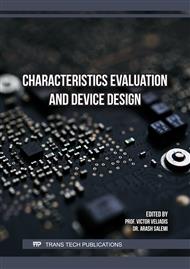p.1
p.9
p.15
p.21
p.29
p.37
p.45
p.53
Design Parameters Impact on Electrical Characteristics of 4H-SiC Thyristors with Etched Junction Termination Extension
Abstract:
4H-SiC thyristors are of particular interest in pulsed power applications due to their ability to block high voltages and transfer high current densities along with fast switching times. Here, we present a paper that demonstrates both (i) the impact of the design parameters on the blocking characteristics based on simulations taking into account the anisotropy of 4H-SiC and (ii) a critical comparison to real devices having equivalent epitaxial structural design. Simulations and measurements show that an etched junction termination extension (JTE) is suitable to design high-voltage SiC thyristors. Concerning breakdown voltage, the real devices data agree to simulations for junction termination extension thickness in the relevant region. Besides the actual JTE thickness and doping concentration, the presence of a relatively thin field-stop layer might explain the discrepancy between experiment and simulation.
Info:
Periodical:
Pages:
1-8
Citation:
Online since:
September 2025
Authors:
Keywords:
Permissions:
Share:
Citation:


